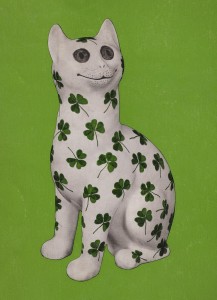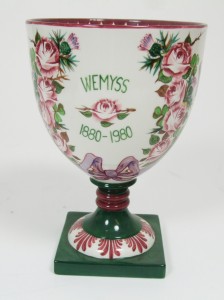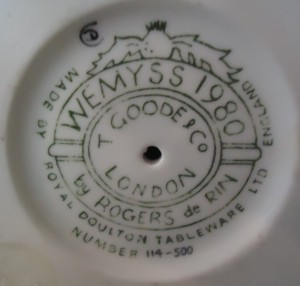The history of Wemyss becomes a little fuzzy at this stage and there are a number of ‘stories’ which appear incorrect based on what is know to be factual, but nevertheless these have gained levels of acceptance by being retold and republished. Much of the confusion lies in what happened to the rights to the Wemyss Ware mark after the demise of the Bovey Pottery. The Bovey Pottery shared the same owners as the Bristol based Pountney Pottery and consequently the assets of Bovey transferred to them. This would have including the orders, stock, marks and moulds. Apparently Pountney’s attempted to produce some Wemyss but failed. It also seems that the Bovey Wemyss moulds were destined for the scrap heap, but it has become evident that some landed with local potteries rather than being destroyed (in fact, some have been used later in contemporary Exon Wemyss Ware production). Pountney’s Pottery closed in 1971 and its assets became owned by A G Richardson & Son (Stoke on Trent). There have been several incorrect stories that Jan Plichta, the London based glass and pottery wholesaler, acquired the rights to Wemyss Ware after the closure of the Bovey Pottery (or even prior to its demise). Plichta did sell his wholesale business to Lawleys in 1958 and this subsequently became part of Royal Doulton. Based on some correct information combined with erroneous assumptions, some have incorrectly assumed that Doulton had acquired the rights to the Wemyss mark. Even Doulton seemed to believe this story at one point.
 From the late fifties and into the early seventies there was little interest in Wemyss Ware. Whoever could have legitimately claimed rights to the Wemyss Ware mark did not at that time come forward and probably no-one considered there to be any commercial value in the rights to a ware that was decades out of fashion and which would most probably never be produced again. However, with Wemyss Ware out of production for some time it was becoming scarce and with fashions continuing to shift it became in favour with collectors, especially in Scotland. In late 1971 the Scottish Arts Council held a successful exhibition of Wemyss Ware in Edinburgh with over 400 exhibits. During the 1970s collectors interest was growing and by the late 1970’s an early Wemyss fish tureen sold for over £1000 at auction, a record for a single piece of Scottish pottery.
From the late fifties and into the early seventies there was little interest in Wemyss Ware. Whoever could have legitimately claimed rights to the Wemyss Ware mark did not at that time come forward and probably no-one considered there to be any commercial value in the rights to a ware that was decades out of fashion and which would most probably never be produced again. However, with Wemyss Ware out of production for some time it was becoming scarce and with fashions continuing to shift it became in favour with collectors, especially in Scotland. In late 1971 the Scottish Arts Council held a successful exhibition of Wemyss Ware in Edinburgh with over 400 exhibits. During the 1970s collectors interest was growing and by the late 1970’s an early Wemyss fish tureen sold for over £1000 at auction, a record for a single piece of Scottish pottery.
 As the Wemyss centenary approached the idea of creating a contemporary commemorative piece was proposed by the London dealer Rogers de Rin. Wemyss commemorative goblets had been produced to mark events such as Queen Victoria’s Diamond Jubilee in 1897. A Wemyss commemorative goblet was therefore produced in 1980 by Royal Doulton to commemorate the Queen Mother’s 80th Birthday (she was a avid Wemyss collector). This goblet was also bizarrely marked as a centenary of Wemyss Ware 1880-1980. The fact that this was 2 years too early was conveniently ‘fixed’ by pretending that Wemyss Ware was produced from 1880 and not 1882 which is of course a documented fact! At this point Doulton also assumed that they owned the rights to the Wemyss mark.
As the Wemyss centenary approached the idea of creating a contemporary commemorative piece was proposed by the London dealer Rogers de Rin. Wemyss commemorative goblets had been produced to mark events such as Queen Victoria’s Diamond Jubilee in 1897. A Wemyss commemorative goblet was therefore produced in 1980 by Royal Doulton to commemorate the Queen Mother’s 80th Birthday (she was a avid Wemyss collector). This goblet was also bizarrely marked as a centenary of Wemyss Ware 1880-1980. The fact that this was 2 years too early was conveniently ‘fixed’ by pretending that Wemyss Ware was produced from 1880 and not 1882 which is of course a documented fact! At this point Doulton also assumed that they owned the rights to the Wemyss mark.
 The goblet itself was marked “Wemyss 1980” and also “Royal Doulton” who produced it, “Rogers de Rin” who had initiated the project and the design, and “T Goode & Co” the Mayfair pottery agent. Esther Weeks, the last head Wemyss decorator from the Bovey Pottery, was asked to help create these but clearly one decorator could not produce many of these in a short period and so a hotch potch of different decorators (of varying talent) were used to produce the limited edition of 500 (although it is not certain if 500 were actually made). Despite this being of dubious legitimacy, variable quality and with incorrect dates this Wemyss Ware pastiche was perhaps another catalyst in the Wemyss revival that was to follow.
The goblet itself was marked “Wemyss 1980” and also “Royal Doulton” who produced it, “Rogers de Rin” who had initiated the project and the design, and “T Goode & Co” the Mayfair pottery agent. Esther Weeks, the last head Wemyss decorator from the Bovey Pottery, was asked to help create these but clearly one decorator could not produce many of these in a short period and so a hotch potch of different decorators (of varying talent) were used to produce the limited edition of 500 (although it is not certain if 500 were actually made). Despite this being of dubious legitimacy, variable quality and with incorrect dates this Wemyss Ware pastiche was perhaps another catalyst in the Wemyss revival that was to follow.
